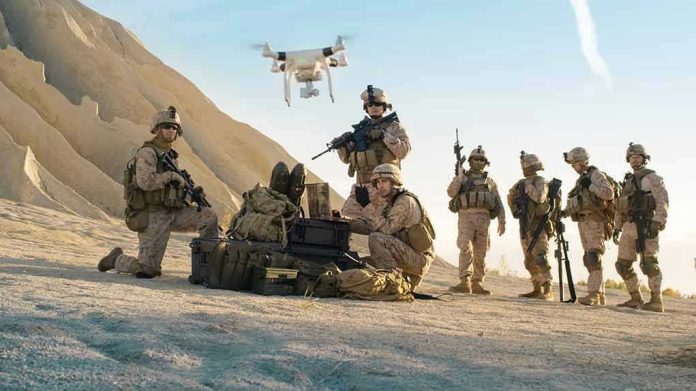
President Trump’s newest military modernization effort shows that American ingenuity, not Pentagon red tape, leads the way in defending against emerging threats.
Story Snapshot
- The Army’s elite 75th Ranger Regiment is testing explosive-laden FPV drones as anti-tank weapons, bypassing bureaucratic obstacles.
- These low-cost drones, inspired by lessons from the Ukraine war, offer a rapid, flexible answer to enemy armor and evolving battlefield tactics.
- The Rangers’ autonomy in experimenting with new tech is influencing broader U.S. Army doctrine and procurement.
- This innovation highlights the urgent need for decisive American adaptation—free from government overreach—to maintain military superiority.
Rangers Field-Test Drones as Anti-Tank Weapons
The 75th Ranger Regiment, one of America’s most respected special operations units, has been conducting live-fire tests using first-person view (FPV) drones equipped with explosives to destroy enemy armored vehicles. This initiative directly responds to the rising use of drones in modern warfare, especially as witnessed in the Ukraine conflict. The Rangers are not waiting for slow-moving Pentagon acquisition processes; instead, they are rapidly fielding commercial-style drones to explore their effectiveness in real-world combat scenarios. This hands-on approach reflects a broader push within the Army to innovate quickly in order to counter evolving threats and maintain a decisive advantage.
The Rangers’ use of FPV drones marks a significant departure from traditional, expensive military hardware. By leveraging hobbyist and commercially available drone technology, the Regiment is able to experiment with cost-effective and flexible solutions for anti-armor operations. This approach allows them to bypass layers of bureaucracy that have long stifled rapid innovation within the Department of Defense. The urgency driving these tests comes from battlefield lessons learned in Eastern Europe, where cheap drones have proven devastatingly effective against even the most advanced armored vehicles. American forces are now adapting those tactics to ensure that U.S. troops are never caught unprepared by technological surprises.
Army Leadership Embraces Rapid Innovation
Senior Army officials, including the Secretary of the Army, have praised the Rangers’ agility, noting that bypassing traditional acquisition channels is essential in today’s fast-changing security environment. The Army is currently integrating these findings into broader modernization efforts, with new simulations and war games that envision drones operating alongside artillery and rocket systems. The goal is to close critical capability gaps between long-range precision weapons and close-in indirect fire, ensuring that American forces remain dominant across all domains. This experimentation is not confined to special operations; leaders are now considering how such tactics might be adopted in conventional units, potentially reshaping U.S. military doctrine for years to come.
The Pentagon’s willingness to let elite units like the Rangers innovate independently represents a shift towards decentralizing military problem-solving. While oversight and standardization remain important for broad force integration, allowing frontline units to test and field new technologies first ensures that practical, battle-tested innovations reach the wider Army faster. This bottom-up approach sharply contrasts with the bureaucratic inertia that often hamstrings large institutions and highlights the value of empowering those closest to the fight. The Rangers’ success could serve as a blueprint for other branches seeking to outpace adversaries through rapid adaptation and technological creativity.
Impacts and Conservative Concerns
In the short term, the Rangers’ drone experimentation provides U.S. forces with a powerful, affordable tool to counter armored threats, potentially saving lives and taxpayer dollars. Over the long term, this initiative may signal a broader doctrinal shift, with unmanned systems and automation taking on greater roles in U.S. military operations. Conservative Americans, wary of wasteful spending and government overreach, can take heart in the Rangers’ ability to innovate outside traditional channels, embodying the principles of efficiency, ingenuity, and self-reliance. However, questions remain about integrating these new capabilities across the entire force without sacrificing oversight or exposing gaps in readiness. As adversaries adapt and the battlefield evolves, continued vigilance and a commitment to constitutional principles—especially regarding defense and limited government—remain vital.
Expert and Industry Perspectives
Military analysts and industry experts widely acknowledge that the U.S. is learning critical lessons from the Ukraine conflict, where drone warfare has tipped the scales against traditional armor. They caution, however, against over-reliance on commercial technologies, warning that adversaries are also rapidly innovating and may exploit vulnerabilities in off-the-shelf systems. Scholars emphasize that while democratizing airpower through cheap drones can disrupt conventional warfare, it also raises ethical and strategic questions about escalation and the proliferation of unmanned weaponry. The Rangers’ approach—experiment, adapt, and deploy—reflects the American tradition of practical problem-solving, but sustained success will require ongoing investment in counter-drone measures and doctrine development to stay ahead in the technology race.
Sources:
Army Experiments Integrating Attack Drones Into Artillery Formations – Defense One
Army Rangers are testing out drones as anti-tank weapons – Task & Purpose







